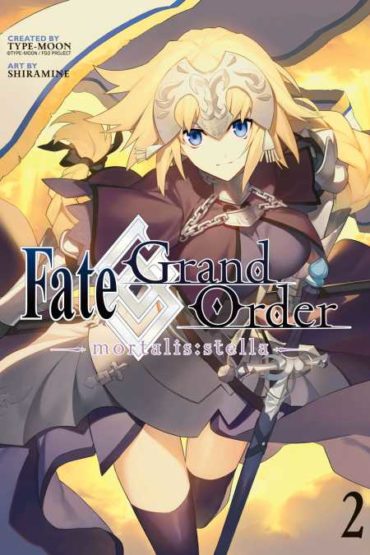Fate/Grand Order -mortalis: stella- Volume 2 Review
Mash and Ritsuka, fresh off the heels of saving the future by fixing an irregularity occurring in January 2004, their future is once again in jeopardy. Now they’re forced to travel back to the year 1431 in France. The country should be at peace, but instead the skies are full of dragons and Jeanne d’Arc has risen from the dead, now full of malice and vengeance. Multiple Servants have also suddenly been summoned, but seemingly without a Master to guide them. Can Mash and Ritsuka fix the past and save the future once again?
It has been over a year since the first volume was released; that’s a huge wait between volumes, considering that the manga first debuted in Japan back in July 2017. Funnily enough, despite the wait, the scope of Fate/Grand Order has only gotten bigger. It was the world’s top grossing game of the New Year period leading into 2020, and considering the state of the world, with everyone forced to stay at home, I highly doubt that figure has decreased. And yet, this game is still not available in the UK. So, for better and for worse, this manga adaptation is the only means of experiencing this story for ourselves. However, the first volume had the hurdle of telling part of the story that already had, arguably, a more enjoyable anime adaptation. This volume continues from that and is fresher for non-players and UK Fate fans.
This new arc of the story doesn’t give the reader any chance to remind themselves of what has happened before or a feel for the characters. In this regard it has the same issues as the opening book: super-rushed pacing. There’s no time to allow the emotional moments to breathe, or for our characters to organically grow, and it’s clear that a lot of these chapters were meant to have more player interaction (combat and such) that obviously can’t really translate into written form. Also, the book haphazardly introduces and then names all the new Servants like there’s no tomorrow. In Fate/Apocrypha it made sense to do this since they were teams and knowing each person’s identity benefitted them all, here it’s just so the reader doesn’t have to guess for too long and keep the plot’s pace high.
But to give credit where it’s due, this story is a lot better than the previous one, and not just because it doesn’t have the anime and game to compare with, but also because of the setting itself. In most Fate stories, it’s either set in an alternative future/present day, and is based upon a Holy Grail War. Even spin-offs that seem to be set in new locations tend not to stray too far from other familiar elements and characters (e.g. Fate/Extra Last Encore). Here, we get a new setting for the franchise (France, 1431), and even though we have Servants, they have not been summoned by usual means and we are also introduced to a ton of new ones, whereas the first volume had the ones we knew from Fate/Stay Night but in new roles with hardly any time to explore that.
The new Servants, design-wise, are a mixed bag. On the one hand there’s a lot of the usual annoyances that come from this franchise in particular: the female servants are either busty women or little girls, and if they’re evil (or Alter versions) then the female are always in sexy outfits, no exceptions. The positive however comes from the sheer variety of them. Because it’s set in the past, and in a new country, it means that we get more new French-based Servants and other European ones joining the party. My particular favourite new addition was the Chevalier d’Eon; for those who don’t know, she was a transgender French spy and solider, and her Fate design keeps true to her historical roots by keeping it gender-fluid in design and mannerisms. There’s also one particular cameo from Fate/Zero, which I won’t spoil, but it is extremely clever if you’ve seen the series and realise why he’s there.
Art is once again provided by Shiramine and the same issues from Volume 1 are here. The backgrounds are bland so we never really get a ‘feel’ for the time period or France’s unique architecture, and the action always feels like we’re missing a frame or two to see what’s truly going on, but the designs of the characters are excellent. There are a few returning characters but in new positions and outfits, and yet they’re instantly recognisable despite the new medium. Kevin Gifford also returns to translate the second volume and it’s a decent job; all characters have their distinct voice, but feels a bit of an afterthought to have some of the French-based characters throw in an occasional French word and others not.
The volume ends midway through the current arc and I hope that it does not take as long for the third volume to come out for the sake of Fate fans. Whilst the story isn’t as engaging as other Fate properties, and will never be as immersive as the original game, this volume has a lot more going for it than the first book did, and that at least counts for something.


